Student Assessment Workbook And Project
Added on 2022-08-15
35 Pages10002 Words18 Views
Student Assessment Workbook
ASSIGNMENT COVER SHEET
Instructions:
Before you start your assessment task, please read the student declaration below.
All assignments must be submitted with this attached cover sheet.
Assignments submitted without this cover sheet or declaration completed, will be returned to the
student for resubmission.
Please keep a copy of your assignment. Your assignment will not be returned to you.
Please submit your assignment by hard copy or email the assignment cover sheet with your
assignment to assignment@alanakaye.edu.au
Email to assignment@alanakaye.edu.au
Qualification Code/Title CHC50113 Diploma of Early Childhood Education and Care
Competency Code/Title CHCECE020 Establish and implement plans for developing cooperative behaviour
Student Name
Student Email
USI Number
Trainer Name
Student Declaration
I confirm: Yes No
I understand the assessment requirements to achieve competence. ☐ ☐
I am ready for assessment. ☐ ☐
I understand the appeals, complaints and grievance procedure (refer to Student Handbook). ☐ ☐
(only complete if you have special needs). I have advised of my special needs and any changes to
the assessment process have been taken into consideration.
☐ ☐
The work in this assignment is my own work. I declare that this assessment item is my own work
unless otherwise acknowledged and referenced.
☐ ☐
I agree:
This assessment may be accessed by the government (Australian Skills Quality Authority,
Government Funding Agencies) or representatives chosen by Alana Kaye Training (eg. Trainers,
Consultant, Industry Representatives) to review the quality and marking of this assessment.
☐ ☐
I have read, understood and accept the above conditions of this assessment.
Signature: Date Submitted:
Cheating and plagiarism: All work submitted must be your own. If a trainer suspects that you have been involved in
plagiarism, the matter will be referred to the Branch Manager or CEO. If two students submit the same or very similar
assessment both students will need to resubmit their assessment.
tmpzxfuqa7q3912535_370125004_1192317.docx Page 1 of 35
ASSIGNMENT COVER SHEET
Instructions:
Before you start your assessment task, please read the student declaration below.
All assignments must be submitted with this attached cover sheet.
Assignments submitted without this cover sheet or declaration completed, will be returned to the
student for resubmission.
Please keep a copy of your assignment. Your assignment will not be returned to you.
Please submit your assignment by hard copy or email the assignment cover sheet with your
assignment to assignment@alanakaye.edu.au
Email to assignment@alanakaye.edu.au
Qualification Code/Title CHC50113 Diploma of Early Childhood Education and Care
Competency Code/Title CHCECE020 Establish and implement plans for developing cooperative behaviour
Student Name
Student Email
USI Number
Trainer Name
Student Declaration
I confirm: Yes No
I understand the assessment requirements to achieve competence. ☐ ☐
I am ready for assessment. ☐ ☐
I understand the appeals, complaints and grievance procedure (refer to Student Handbook). ☐ ☐
(only complete if you have special needs). I have advised of my special needs and any changes to
the assessment process have been taken into consideration.
☐ ☐
The work in this assignment is my own work. I declare that this assessment item is my own work
unless otherwise acknowledged and referenced.
☐ ☐
I agree:
This assessment may be accessed by the government (Australian Skills Quality Authority,
Government Funding Agencies) or representatives chosen by Alana Kaye Training (eg. Trainers,
Consultant, Industry Representatives) to review the quality and marking of this assessment.
☐ ☐
I have read, understood and accept the above conditions of this assessment.
Signature: Date Submitted:
Cheating and plagiarism: All work submitted must be your own. If a trainer suspects that you have been involved in
plagiarism, the matter will be referred to the Branch Manager or CEO. If two students submit the same or very similar
assessment both students will need to resubmit their assessment.
tmpzxfuqa7q3912535_370125004_1192317.docx Page 1 of 35
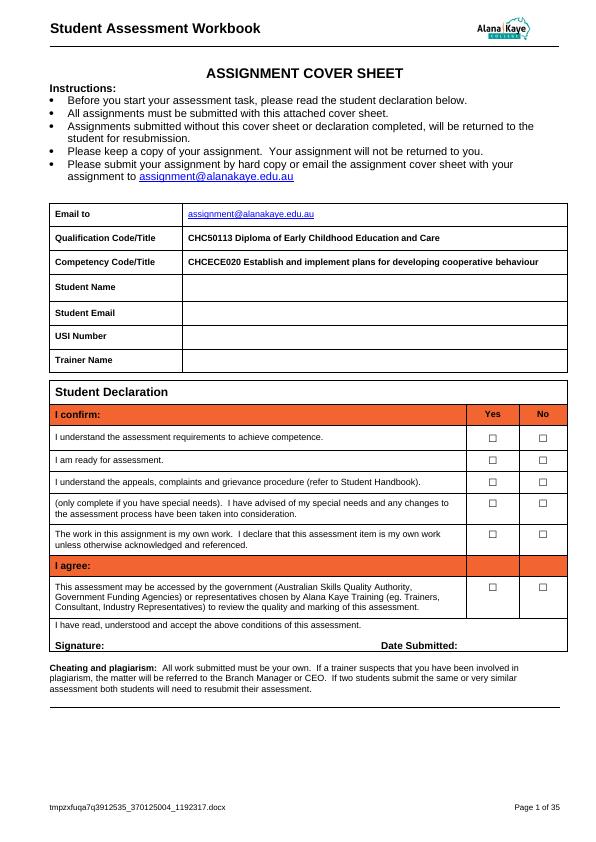
Student Assessment Workbook
This page has been left blank intentionally
tmpzxfuqa7q3912535_370125004_1192317.docx Page 2 of 35
This page has been left blank intentionally
tmpzxfuqa7q3912535_370125004_1192317.docx Page 2 of 35
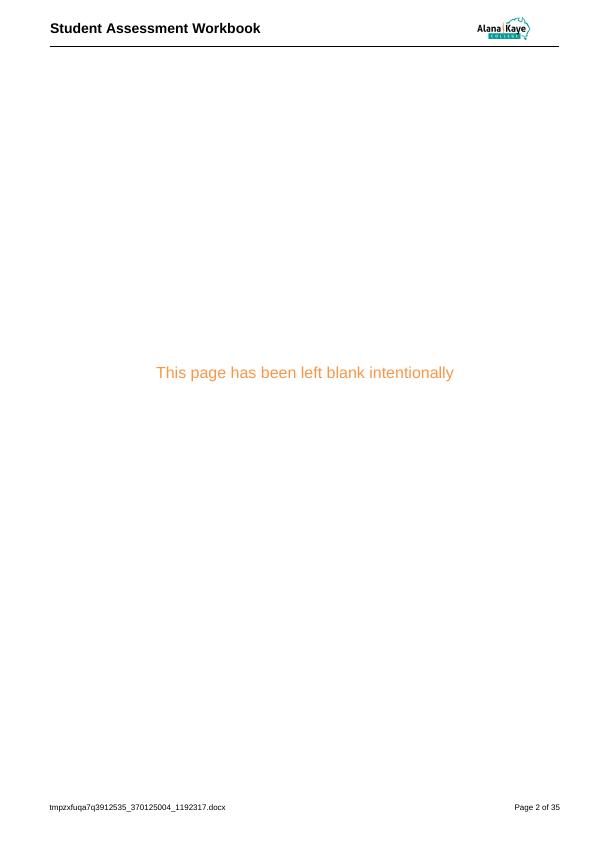
Student Assessment Workbook
COMPETENCY JUDGEMENT – TRAINER/ASSESSOR USE ONLY
Instructions:
This document is used by the Assessor to record their feedback about your assessment.
This competency judgement record will be returned to you. If you do not agree with the judgement,
students can access Alana Kaye’s complaints and appeals process.
Qualification Code/Title CHC50113 Diploma of Early Childhood Education and Care
Competency Code/Title CHCECE020 Establish and implement plans for developing cooperative behaviour
Student Name
Assessor Name
STUDENTS MUST NOT COMPLETE THE FOLLOWING FEEDBACK – ASSESSOR ONLY
ASSESSOR’S FEEBACK TO STUDENT
(include resubmission requirements and due date, if applicable)
Assessment Task Result (S = satisfactory; NS = not yet satisfactory) S NS
Assessment Task 1 - Establishing and applying limits and guidelines for behaviour
Assessment Task 2 - Identifying and reviewing behaviour as required
Assessment Task 3 - Developing a plan to guide a particular child’s behaviour where
required
Assessment Task 4 - Implementing and monitoring a behaviour plan
Feedback
Assessment Task 5 – Workplace tasks
Feedback
Assessment Task 6 – Project
Questions 1 – 7
Feedback
Overall Assessor Comments:
Final assessment result: Resubmission result:
☐ COMPETENT ☐ COMPETENT
☐ NOT YET COMPETENT ☐ NOT YET COMPETENT
Assessor Name
Assessor Signature Date
Administration Resulted
VETtrak & tracking spreadsheet updated
ACS & CJ scanned & saved
Copy sent to student
Initial:
Date:
tmpzxfuqa7q3912535_370125004_1192317.docx Page 3 of 35
COMPETENCY JUDGEMENT – TRAINER/ASSESSOR USE ONLY
Instructions:
This document is used by the Assessor to record their feedback about your assessment.
This competency judgement record will be returned to you. If you do not agree with the judgement,
students can access Alana Kaye’s complaints and appeals process.
Qualification Code/Title CHC50113 Diploma of Early Childhood Education and Care
Competency Code/Title CHCECE020 Establish and implement plans for developing cooperative behaviour
Student Name
Assessor Name
STUDENTS MUST NOT COMPLETE THE FOLLOWING FEEDBACK – ASSESSOR ONLY
ASSESSOR’S FEEBACK TO STUDENT
(include resubmission requirements and due date, if applicable)
Assessment Task Result (S = satisfactory; NS = not yet satisfactory) S NS
Assessment Task 1 - Establishing and applying limits and guidelines for behaviour
Assessment Task 2 - Identifying and reviewing behaviour as required
Assessment Task 3 - Developing a plan to guide a particular child’s behaviour where
required
Assessment Task 4 - Implementing and monitoring a behaviour plan
Feedback
Assessment Task 5 – Workplace tasks
Feedback
Assessment Task 6 – Project
Questions 1 – 7
Feedback
Overall Assessor Comments:
Final assessment result: Resubmission result:
☐ COMPETENT ☐ COMPETENT
☐ NOT YET COMPETENT ☐ NOT YET COMPETENT
Assessor Name
Assessor Signature Date
Administration Resulted
VETtrak & tracking spreadsheet updated
ACS & CJ scanned & saved
Copy sent to student
Initial:
Date:
tmpzxfuqa7q3912535_370125004_1192317.docx Page 3 of 35
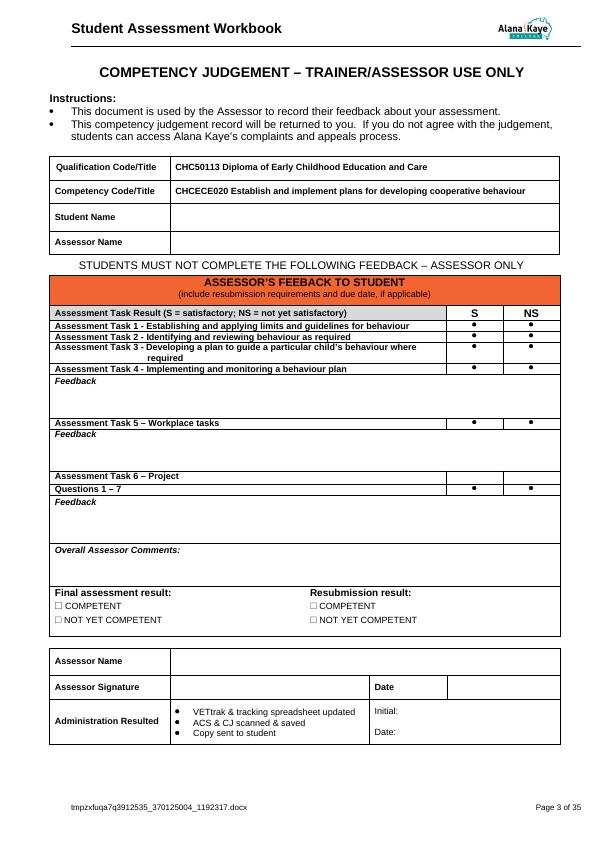
Student Assessment Workbook
CHCECE020 Establish and implement plans for developing cooperative
behaviour
This document comprises of 2 sections:
Section One – Unit and Assessment Overview
Section Two – Assessment Tasks
Section One – Unit and Assessment Overview provides you with an overview of the knowledge and skills that you
need to demonstrate in the assessment tasks. The Unit and Assessment Overview also provides you with information
about the assessment conditions, the topics covered in this unit, the Assessor’s role, changes to the assessment
procedure that can be made to accommodate your needs and instructions to students including how to submit your
assessment tasks.
Section Two – Assessment Tasks consists of questions, case studies and work based activities. These tasks are used
to demonstrate that you meet the requirements as detailed in Section One – Unit and Assessment Overview.
SECTION ONE: UNIT AND ASSESSMENT OVERVIEW
Performance Evidence
The candidate must show evidence of the ability to complete tasks outlined in elements and performance criteria of this
unit, manage tasks and manage contingencies in the context of the job role. There must be demonstrated evidence that
the candidate has completed the following tasks:
observed and analysed children’s behaviour, on at least three occasions, in a range of situations and contexts
created, implemented and measured the effectiveness of at least one plan, including:
developing long-term and short-term goals and objectives
o establishing a baseline for the behaviour
o clearly outlining alternative behaviours
o communicating expectations with children
o supporting and communicating with colleagues to implement the plan
o revisiting the plan and reflecting on its effectiveness
developed positive relationships with children, respected family expectations and their cultural values, and acted
within the service policy
interacted with children and involved them in decision-making and planning.
Knowledge Evidence
The candidate must be able to demonstrate essential knowledge required to effectively do the task outlined in elements
and performance criteria of this unit, manage the task and manage contingencies in the context of the identified work
role.
These include knowledge of:
how to access:
o the National Quality Framework
o the National Quality Standards
o the relevant approved learning framework
how to interpret the relevance of framework and standards documents in guiding work in this unit of competency
stage of development/age-appropriate expectations of children’s behaviour
appropriate and inappropriate behaviours – review of own stance and reflection on own values
different family styles of discipline and beliefs about behaviour in different cultures and social groups
relationship-based strategies to help children learn about behaviour
possible contributing factors to behaviours of concern, i.e. recent events, child’s history, actions of others, or
developmental or emotional reasons
code of ethics
United Nations Conventions on the Rights of the Child
organisation standards, policies and procedures.
Assessment Conditions
Skills must be demonstrated in a regulated education and care service. In addition, simulations and scenarios must be
used where the full range of contexts and situations cannot be provided in the workplace or may occur only rarely. These
are situations relating to emergency or unplanned procedures where assessment in these circumstances would be
unsafe or is impractical.
Simulated assessment environments must simulate the real-life working environment where these skills and knowledge
would be performed, with all the relevant equipment and resources of that working environment.
Assessment must ensure use of:
National Quality Framework for Early Childhood Education and Care
tmpzxfuqa7q3912535_370125004_1192317.docx Page 4 of 35
CHCECE020 Establish and implement plans for developing cooperative
behaviour
This document comprises of 2 sections:
Section One – Unit and Assessment Overview
Section Two – Assessment Tasks
Section One – Unit and Assessment Overview provides you with an overview of the knowledge and skills that you
need to demonstrate in the assessment tasks. The Unit and Assessment Overview also provides you with information
about the assessment conditions, the topics covered in this unit, the Assessor’s role, changes to the assessment
procedure that can be made to accommodate your needs and instructions to students including how to submit your
assessment tasks.
Section Two – Assessment Tasks consists of questions, case studies and work based activities. These tasks are used
to demonstrate that you meet the requirements as detailed in Section One – Unit and Assessment Overview.
SECTION ONE: UNIT AND ASSESSMENT OVERVIEW
Performance Evidence
The candidate must show evidence of the ability to complete tasks outlined in elements and performance criteria of this
unit, manage tasks and manage contingencies in the context of the job role. There must be demonstrated evidence that
the candidate has completed the following tasks:
observed and analysed children’s behaviour, on at least three occasions, in a range of situations and contexts
created, implemented and measured the effectiveness of at least one plan, including:
developing long-term and short-term goals and objectives
o establishing a baseline for the behaviour
o clearly outlining alternative behaviours
o communicating expectations with children
o supporting and communicating with colleagues to implement the plan
o revisiting the plan and reflecting on its effectiveness
developed positive relationships with children, respected family expectations and their cultural values, and acted
within the service policy
interacted with children and involved them in decision-making and planning.
Knowledge Evidence
The candidate must be able to demonstrate essential knowledge required to effectively do the task outlined in elements
and performance criteria of this unit, manage the task and manage contingencies in the context of the identified work
role.
These include knowledge of:
how to access:
o the National Quality Framework
o the National Quality Standards
o the relevant approved learning framework
how to interpret the relevance of framework and standards documents in guiding work in this unit of competency
stage of development/age-appropriate expectations of children’s behaviour
appropriate and inappropriate behaviours – review of own stance and reflection on own values
different family styles of discipline and beliefs about behaviour in different cultures and social groups
relationship-based strategies to help children learn about behaviour
possible contributing factors to behaviours of concern, i.e. recent events, child’s history, actions of others, or
developmental or emotional reasons
code of ethics
United Nations Conventions on the Rights of the Child
organisation standards, policies and procedures.
Assessment Conditions
Skills must be demonstrated in a regulated education and care service. In addition, simulations and scenarios must be
used where the full range of contexts and situations cannot be provided in the workplace or may occur only rarely. These
are situations relating to emergency or unplanned procedures where assessment in these circumstances would be
unsafe or is impractical.
Simulated assessment environments must simulate the real-life working environment where these skills and knowledge
would be performed, with all the relevant equipment and resources of that working environment.
Assessment must ensure use of:
National Quality Framework for Early Childhood Education and Care
tmpzxfuqa7q3912535_370125004_1192317.docx Page 4 of 35
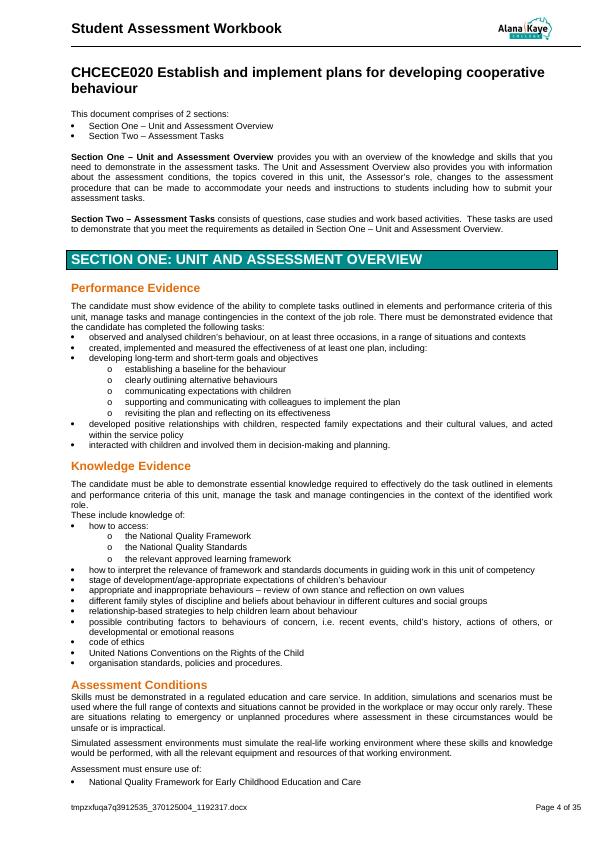
Student Assessment Workbook
the relevant approved learning framework under the National Quality Framework for Early Childhood Education and
Care.
Assessors must satisfy the Standards for Registered Training Organisations (RTOs) 2015/AQTF mandatory competency
requirements for assessors.
Topics Covered
The topics covered in this unit include:
Establishing and applying limits and guidelines for behaviour
Identifying and reviewing behaviour as required
Developing a plan to guide a child’s behaviour where required
Implementing and monitoring a behaviour plan
Additional reference material and research website
If you need to refer to a specific resource to complete your assessment task, we will identify the resource within the
assessment task. Additional resources that you may find useful include:
www.earlychildhoodaustralia.org.au
www.ecareconciliationsymposium.com.au
www.education.gov.au/early-years-learning-framework
www.aussiechildcarenetwork.com.au
www.ccccnsw.org.au/wp-content/uploads/EYLF_Ed_Guide_Dec2010.pdf
Reasonable Adjustments
Your Assessor may be able to make adjustments to your assessment based on special needs you may have or if you are
a distance learning student. Please ask your Trainer if you feel that modifications to this assessment are required.
Student Handbook
Please refer to Alana Kaye’s Student Handbook about:
Educational and Student Support Services
Trainer Support
Assessment Strategy
Appeals, Complaints and Grievances Procedures
Role of the Trainer/Assessor
Your Trainer/Assessor will:
answer any questions you might have about the assessment
negotiate assessment activities if reasonable adjustment is required
inform you of any variations to the assessment which may be required if you have any special needs or if you are a
distance based learner
assess your competency by making judgements about the evidenced presented in line with the rules of evidence:
validity, authenticity, currency and sufficiency
give you feedback on the outcomes of the assessment process
counsel you on the outcomes of the assessment including advising you of your right of appeal if you disagree with
the assessment decision
help you address the work health and safety requirements of the assessment setting, if appropriate.
Instructions for students
In order to successfully meet the requirements of this unit you are required to undertake all assessment tasks. Each of
these assessment tasks may have a series of activities or questions that you are required to complete.
Please note that at Diploma level it is expected that the questions will be answered in a manner that reflects significant
understanding of the theory associated with the unit of competency. You are required to elaborate upon the answer
sufficiently articulating your understating of the underpinning knowledge required for this unit of competency.
As a guide – each question will generally require 1 - 2 paragraphs to effectively address requirements. In some cases,
this may be more. If you, in the course of answering a question, rely upon a text, document, webpage or other source of
information, you must make reference to where this information came from.
You are required to submit:
Student Assessment Workbook – this workbook needs to be submitted by the due date identified on your timetable.
Please refer to the Student Work Placement Guidelines for instructions about your work placement. This includes the
assessment requirements of this qualification including:
Student Work Placement Third Party Report
tmpzxfuqa7q3912535_370125004_1192317.docx Page 5 of 35
the relevant approved learning framework under the National Quality Framework for Early Childhood Education and
Care.
Assessors must satisfy the Standards for Registered Training Organisations (RTOs) 2015/AQTF mandatory competency
requirements for assessors.
Topics Covered
The topics covered in this unit include:
Establishing and applying limits and guidelines for behaviour
Identifying and reviewing behaviour as required
Developing a plan to guide a child’s behaviour where required
Implementing and monitoring a behaviour plan
Additional reference material and research website
If you need to refer to a specific resource to complete your assessment task, we will identify the resource within the
assessment task. Additional resources that you may find useful include:
www.earlychildhoodaustralia.org.au
www.ecareconciliationsymposium.com.au
www.education.gov.au/early-years-learning-framework
www.aussiechildcarenetwork.com.au
www.ccccnsw.org.au/wp-content/uploads/EYLF_Ed_Guide_Dec2010.pdf
Reasonable Adjustments
Your Assessor may be able to make adjustments to your assessment based on special needs you may have or if you are
a distance learning student. Please ask your Trainer if you feel that modifications to this assessment are required.
Student Handbook
Please refer to Alana Kaye’s Student Handbook about:
Educational and Student Support Services
Trainer Support
Assessment Strategy
Appeals, Complaints and Grievances Procedures
Role of the Trainer/Assessor
Your Trainer/Assessor will:
answer any questions you might have about the assessment
negotiate assessment activities if reasonable adjustment is required
inform you of any variations to the assessment which may be required if you have any special needs or if you are a
distance based learner
assess your competency by making judgements about the evidenced presented in line with the rules of evidence:
validity, authenticity, currency and sufficiency
give you feedback on the outcomes of the assessment process
counsel you on the outcomes of the assessment including advising you of your right of appeal if you disagree with
the assessment decision
help you address the work health and safety requirements of the assessment setting, if appropriate.
Instructions for students
In order to successfully meet the requirements of this unit you are required to undertake all assessment tasks. Each of
these assessment tasks may have a series of activities or questions that you are required to complete.
Please note that at Diploma level it is expected that the questions will be answered in a manner that reflects significant
understanding of the theory associated with the unit of competency. You are required to elaborate upon the answer
sufficiently articulating your understating of the underpinning knowledge required for this unit of competency.
As a guide – each question will generally require 1 - 2 paragraphs to effectively address requirements. In some cases,
this may be more. If you, in the course of answering a question, rely upon a text, document, webpage or other source of
information, you must make reference to where this information came from.
You are required to submit:
Student Assessment Workbook – this workbook needs to be submitted by the due date identified on your timetable.
Please refer to the Student Work Placement Guidelines for instructions about your work placement. This includes the
assessment requirements of this qualification including:
Student Work Placement Third Party Report
tmpzxfuqa7q3912535_370125004_1192317.docx Page 5 of 35
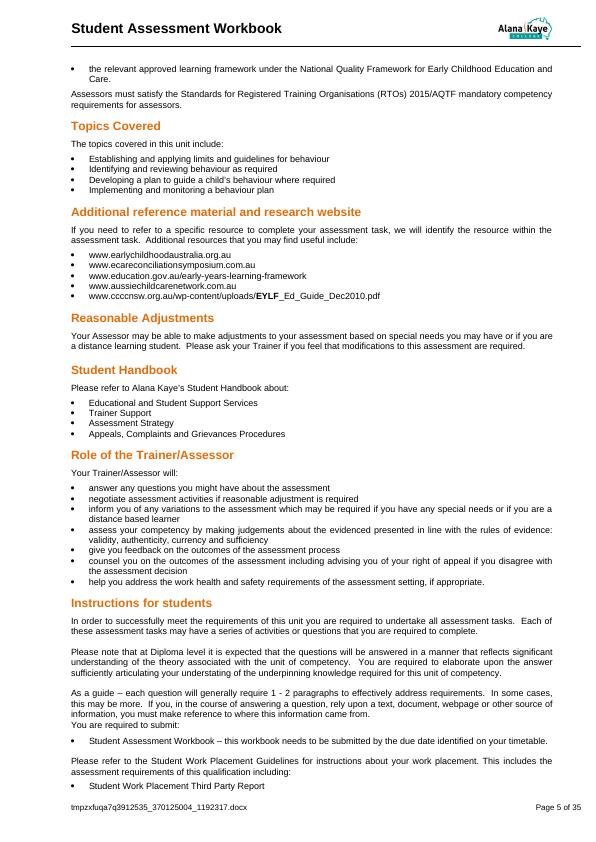
Student Assessment Workbook
Student Workplace Logbook and Learning Activities or letter of tenure to demonstrate the minimum 240 hours of
mandatory work placement.
Submitting your Assessment and Due Dates
Your Trainer will advise you of the due date for each assessment. Please submit your assessment by the due date. The
process for submitting assessments is provided on the assignment coversheet on page 1 of this document.
Feedback on your Assessment
Your Trainer will mark your assessment within 4 weeks of submission. Your Trainer will provide you with feedback about
your assessment. Your result for the Student Assessment Workbook will either be:
Satisfactory – you have successfully passed the workbook requirements OR
Not Satisfactory – you are not yet satisfactory.
If your result is ‘Not Satisfactory’ you will be given an opportunity to improve your assessment. Your Trainer will inform
you of the skill or knowledge gaps in your assessment. You will need to resubmit your assessment with the corrections or
redo the practical exercise until you achieve the ‘Satisfactory’ result. Any student who plagiarises or cheats will be given
a ‘Not Satisfactory’ result and will be required to resubmit their assessment again and may also be required to answer
verbal questions.
Once you have completed both the Student Assessment Workbook and the work placement assessment requirements
your results will be either:
Competency Achieved – you passed OR
Not Yet Competent.
Work Placement Guidelines
All students are required to complete 240 hours of work placement in a regulated education and care service, students
must have a minimum Diploma trained staff member supervising them throughout the 240 hours.
Students need to be aware that Family Day Care can only be used as a work placement setting if the Family Day Care
supervising them holds a Diploma and there are at least 3 different children aged 0-2 and 3 different children aged 2-6
enrolled on the same day. School Aged Care settings are not accepted as work placement settings for this course.
The CHC50113 Diploma of Early Childhood Education and Care includes a mandatory work placement of 240 hours to
cover the range of activities as outlined in the evidence requirements of the following units:
CHCECE003 Provide care for children (if not completed in Certificate III)
CHCECE005 Provide care for babies and toddlers (if not completed in Certificate III)
CHCECE007 Develop positive and respectful relationships with children (if not completed in Certificate III)
CHCECE010 Support the holistic development of children in early childhood (if not completed in Certificate III)
CHCECE017 Foster the holistic development and wellbeing of the child in early childhood
CHCECE019 Facilitate compliance in an education and care service (min 120)
CHCECE024 Design and implement the curriculum to foster children’s learning and development
Supplementary Evidence
Competence in this unit also requires further supplementary evidence. If a Candidate is working within a child care facility
they will be required to provide a Third Party Report and Third Party Evidence Collection Agreement from a suitably
qualified member of staff plus an Alana Kaye Assessor will be required to complete a workplace visit and observe the
candidate in the completion of their tasks.
Working with Children card (Ochre card) NT
It is mandatory for people who have contact or potential contact with children in certain specified areas of employment to
hold a Working with Children Clearance Notice. States and Territories may have different requirements and it is best to
check.
For further information on NT requirements contact: Email: safent.police@pfes.nt.gov.au
Phone: Freecall: 1800 SAFE NT (1800 72 33 68 - Australia wide callers only) or (08) 8985 8985
Complaints and Appeals Procedures
Alana Kaye has a Quality Management System documenting any appeals or complaints to ensure they are addressed
efficiently and effectively. Should you wish to lodge an appeal or complaint in relation to your assessment, please follow
the Complaints and Appeals procedure detailed in the Student Handbook. In the first instance, we encourage you talk
with your Trainer.
PART TWO: ASSESSMENT TASKS
tmpzxfuqa7q3912535_370125004_1192317.docx Page 6 of 35
Student Workplace Logbook and Learning Activities or letter of tenure to demonstrate the minimum 240 hours of
mandatory work placement.
Submitting your Assessment and Due Dates
Your Trainer will advise you of the due date for each assessment. Please submit your assessment by the due date. The
process for submitting assessments is provided on the assignment coversheet on page 1 of this document.
Feedback on your Assessment
Your Trainer will mark your assessment within 4 weeks of submission. Your Trainer will provide you with feedback about
your assessment. Your result for the Student Assessment Workbook will either be:
Satisfactory – you have successfully passed the workbook requirements OR
Not Satisfactory – you are not yet satisfactory.
If your result is ‘Not Satisfactory’ you will be given an opportunity to improve your assessment. Your Trainer will inform
you of the skill or knowledge gaps in your assessment. You will need to resubmit your assessment with the corrections or
redo the practical exercise until you achieve the ‘Satisfactory’ result. Any student who plagiarises or cheats will be given
a ‘Not Satisfactory’ result and will be required to resubmit their assessment again and may also be required to answer
verbal questions.
Once you have completed both the Student Assessment Workbook and the work placement assessment requirements
your results will be either:
Competency Achieved – you passed OR
Not Yet Competent.
Work Placement Guidelines
All students are required to complete 240 hours of work placement in a regulated education and care service, students
must have a minimum Diploma trained staff member supervising them throughout the 240 hours.
Students need to be aware that Family Day Care can only be used as a work placement setting if the Family Day Care
supervising them holds a Diploma and there are at least 3 different children aged 0-2 and 3 different children aged 2-6
enrolled on the same day. School Aged Care settings are not accepted as work placement settings for this course.
The CHC50113 Diploma of Early Childhood Education and Care includes a mandatory work placement of 240 hours to
cover the range of activities as outlined in the evidence requirements of the following units:
CHCECE003 Provide care for children (if not completed in Certificate III)
CHCECE005 Provide care for babies and toddlers (if not completed in Certificate III)
CHCECE007 Develop positive and respectful relationships with children (if not completed in Certificate III)
CHCECE010 Support the holistic development of children in early childhood (if not completed in Certificate III)
CHCECE017 Foster the holistic development and wellbeing of the child in early childhood
CHCECE019 Facilitate compliance in an education and care service (min 120)
CHCECE024 Design and implement the curriculum to foster children’s learning and development
Supplementary Evidence
Competence in this unit also requires further supplementary evidence. If a Candidate is working within a child care facility
they will be required to provide a Third Party Report and Third Party Evidence Collection Agreement from a suitably
qualified member of staff plus an Alana Kaye Assessor will be required to complete a workplace visit and observe the
candidate in the completion of their tasks.
Working with Children card (Ochre card) NT
It is mandatory for people who have contact or potential contact with children in certain specified areas of employment to
hold a Working with Children Clearance Notice. States and Territories may have different requirements and it is best to
check.
For further information on NT requirements contact: Email: safent.police@pfes.nt.gov.au
Phone: Freecall: 1800 SAFE NT (1800 72 33 68 - Australia wide callers only) or (08) 8985 8985
Complaints and Appeals Procedures
Alana Kaye has a Quality Management System documenting any appeals or complaints to ensure they are addressed
efficiently and effectively. Should you wish to lodge an appeal or complaint in relation to your assessment, please follow
the Complaints and Appeals procedure detailed in the Student Handbook. In the first instance, we encourage you talk
with your Trainer.
PART TWO: ASSESSMENT TASKS
tmpzxfuqa7q3912535_370125004_1192317.docx Page 6 of 35
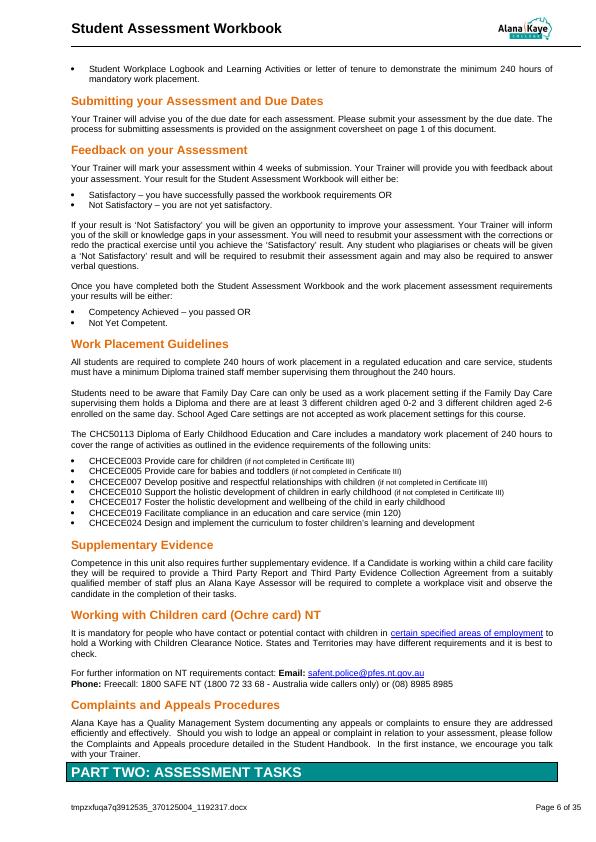
Student Assessment Workbook
Before you commence this assessment, please read the student declaration on the front page. It
is important that you are ready for assessment and understand the assessment process. Please
speak with your Trainer if you have any questions.
Assessment Task 1
Establishing and applying limits and guidelines for behaviour
Purpose
This assessment task is designed to assess your skills and knowledge in establishing and applying
limits and guidelines for behaviour.
Requirements
To complete this assessment task, you need:
access to a children’s services environment
access to the National Quality Framework and National Quality Standard
access to the relevant approved learning framework
access to service policies for children’s behaviour and responding to incidents
to answer the questions and submit responses as directed by your trainer/assessor/training
organisation.
1. Keep a logbook for one week (5 days) while you are working with children. Record at least two
times that you responded to a behaviour incident in a timely manner, using a clear, consistent
and calm approach.
For each entry, include the following information, ensuring confidentiality is maintained, where
necessary.
Log entry
Child: Gracy
Date: 02/02/2020
Age: 3 years
Setting: Playroom
Who else was involved Mr. Jonas and the entire classroom
How you responded to the incident; for example, using
redirection, ‘I’ messages or consequences
Gracy was climbing on the table, 'I'
message has been implemented.
Such as I am scared if you fall down
How you supported the child to manage their own behaviour;
for example, positive reinforcement, encouragement, positive
language, nonverbal strategies, role-modelling, choice or
problem-solving
Role modeling is practiced to
manage the behaviour of the child.
How you interacted with the child to involve them in decision-
making and planning
Listening to them and then by giving
an example of the post effect of the
behaviour
Choose an activity from your service. Work with a group of children to develop limits and guidelines
for the activity.
tmpzxfuqa7q3912535_370125004_1192317.docx Page 7 of 35
Before you commence this assessment, please read the student declaration on the front page. It
is important that you are ready for assessment and understand the assessment process. Please
speak with your Trainer if you have any questions.
Assessment Task 1
Establishing and applying limits and guidelines for behaviour
Purpose
This assessment task is designed to assess your skills and knowledge in establishing and applying
limits and guidelines for behaviour.
Requirements
To complete this assessment task, you need:
access to a children’s services environment
access to the National Quality Framework and National Quality Standard
access to the relevant approved learning framework
access to service policies for children’s behaviour and responding to incidents
to answer the questions and submit responses as directed by your trainer/assessor/training
organisation.
1. Keep a logbook for one week (5 days) while you are working with children. Record at least two
times that you responded to a behaviour incident in a timely manner, using a clear, consistent
and calm approach.
For each entry, include the following information, ensuring confidentiality is maintained, where
necessary.
Log entry
Child: Gracy
Date: 02/02/2020
Age: 3 years
Setting: Playroom
Who else was involved Mr. Jonas and the entire classroom
How you responded to the incident; for example, using
redirection, ‘I’ messages or consequences
Gracy was climbing on the table, 'I'
message has been implemented.
Such as I am scared if you fall down
How you supported the child to manage their own behaviour;
for example, positive reinforcement, encouragement, positive
language, nonverbal strategies, role-modelling, choice or
problem-solving
Role modeling is practiced to
manage the behaviour of the child.
How you interacted with the child to involve them in decision-
making and planning
Listening to them and then by giving
an example of the post effect of the
behaviour
Choose an activity from your service. Work with a group of children to develop limits and guidelines
for the activity.
tmpzxfuqa7q3912535_370125004_1192317.docx Page 7 of 35

Student Assessment Workbook
2. Explain the activity to your trainer/assessor or complete the assessment while they are
observing you by answering these questions:
a) What is the activity and why did you choose it?
b) How many children participated and what was their age and stage of development?
c) What limits and guidelines did the children identify?
d) How were these limits and guidelines appropriate?
e) Describe one occasion where the limits and guidelines were referred to during the activity.
The activity is chosen for establishing limits as well as guidelines within
children. The best activity for this can be a puzzle game. In this activity,
children can form a group of two and can proceed with the activity. The
children between the age group of one and two can participate in this
activity. The stage of development will be toddlers. Children can develop the
thinking capability within themselves, as they are playing within the group;
they will incorporate the cooperative behaviour. While arranging the puzzles,
they will learn a basic description of the limits. They will learn to follow the
guidelines. For illustration, while arranging back the puzzle, the educator
must say like “it is a decent impression to put the puzzle away” instead of just
saying roughly.
3. Work with the children to develop a poster that show the limits and guidelines for their
reference. Then display the poster adjacent to the activity.
Provide a photo of the poster
tmpzxfuqa7q3912535_370125004_1192317.docx Page 8 of 35
2. Explain the activity to your trainer/assessor or complete the assessment while they are
observing you by answering these questions:
a) What is the activity and why did you choose it?
b) How many children participated and what was their age and stage of development?
c) What limits and guidelines did the children identify?
d) How were these limits and guidelines appropriate?
e) Describe one occasion where the limits and guidelines were referred to during the activity.
The activity is chosen for establishing limits as well as guidelines within
children. The best activity for this can be a puzzle game. In this activity,
children can form a group of two and can proceed with the activity. The
children between the age group of one and two can participate in this
activity. The stage of development will be toddlers. Children can develop the
thinking capability within themselves, as they are playing within the group;
they will incorporate the cooperative behaviour. While arranging the puzzles,
they will learn a basic description of the limits. They will learn to follow the
guidelines. For illustration, while arranging back the puzzle, the educator
must say like “it is a decent impression to put the puzzle away” instead of just
saying roughly.
3. Work with the children to develop a poster that show the limits and guidelines for their
reference. Then display the poster adjacent to the activity.
Provide a photo of the poster
tmpzxfuqa7q3912535_370125004_1192317.docx Page 8 of 35
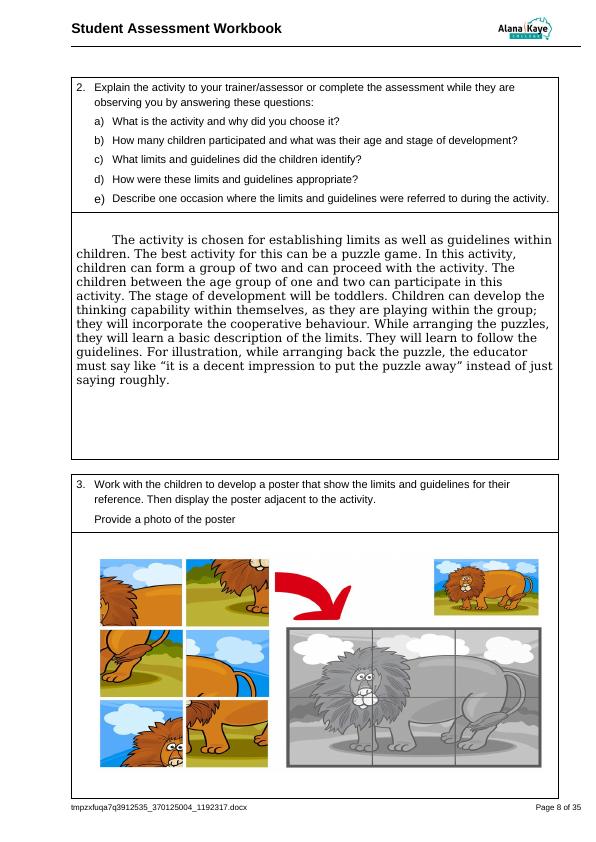
End of preview
Want to access all the pages? Upload your documents or become a member.
Related Documents
CHCECE017 Foster the holistic development and wellbeing of the child in early childhoodlg...
|36
|9275
|483
A European Comparative Studylg...
|42
|10528
|24
Student Assessment Workbooklg...
|29
|10642
|48
Student Assessment Workbooklg...
|31
|9103
|33
CHCECE024 Design and Implement Curriculum for Children's Learning and Developmentlg...
|29
|8708
|202
CHCECE023: Analyse Information to Inform Learning (Core Unit) Assessmentlg...
|34
|9885
|48
